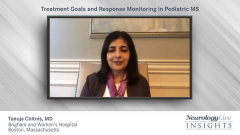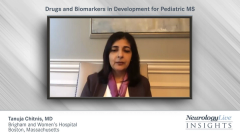
Diagnostic Testing for Pediatric Multiple Sclerosis
Expert neurologist Lauren B. Krupp, MD provides insight into the use of diagnostic tools for pediatric multiple sclerosis such as MRI imaging, laboratory blood tests, and lumbar punctures.
Episodes in this series

Lauren B. Krupp, MD: On the other hand, a youngster with a relapsing-remitting course in whom MS [multiple sclerosis] is a suspected diagnosis should be evaluated certainly with an MRI of the brain, cervical or thoracic spinal cord, with and without contrast. Laboratory studies should rule out other mimics, such as aquaporin-4 or neuromyelitis optica. MOG, myelin oligodendrocyte glycoprotein syndrome, can be a mimic of MS, and MOG antibodies should be drawn as well and checked; both of these tests are done in the blood. Not infrequently, if patients are hospitalized and admitted, it’s useful to get a lumbar puncture looking for the presence of oligoclonal bands or elevated IgG [immunoglobulin G] index. It’s very important that blood be obtained at the same time as the spinal fluid so it can be determined whether the presence of oligoclonal bands in the CSF [cerebrospinal fluid] outnumber those that are in the serum. The history, the examination, the MRI, laboratory studies to exclude other causes and/or mimics, and spinal fluid, are all critical elements in the diagnosis. The degree to which a spinal tap is necessary may vary on what the clinical presentation is, the age of the child, and the circumstances of their presentation.
The differences in MRI between the pediatric and the adult age groups are largely related among the older patients, the adolescents, to the greater inflammatory disease burden that we see in younger versus older patients. For example, young adults compared to older adults are more likely to have more gadolinium-enhancing lesions, and are more likely if not on treatment to accrue new inflammatory lesions. The same is true comparing adolescents to adults; adolescents tend to have more inflammatory lesions, and a greater number of enhancing lesions, even though their neurologic exam may show fewer deficits. The youngest children are more difficult diagnostically; their lesions may be less discrete than we ordinarily expect to see in MS. However, the presence of a periventricular location, the presence of black holes are MRI features that are very useful in distinguishing MS from other conditions, such as ADEM, acute disseminated encephalomyelitis, or other neuroinflammatory disorders.
The question of how can we detect MS early is an important one. It’s a challenge because in very young children, there may be no report to the parents that something is wrong. The kid has some symptoms, they don’t mention them. Really only later when you dig into the history do you get the full picture. On the other hand, you don’t want to have parents or pediatricians become hypervigilant about attention to transient sensory disturbances or cramps from overexertion that are all part of normal day-to-day functioning. I would say that if a child develops a neurologic change that persists for more than 24 hours, that is noticeable to the parent and child, whether it’s sensory, motor, vision-related changes, changes in balance or walking, these things shouldn’t happen. It’s not normal for a child to out of the blue develop a change in neurologic function that lasts more than 24 hours. Helping pediatricians recognize the importance of neurologic changes, and also understanding that the characteristic in the pediatric age group is that though dysfunction occurs, it is not progressive. Typically in MS as I mentioned, neurologic events occur, but then they slowly get better.
Transcript Edited for Clarity
Newsletter
Keep your finger on the pulse of neurology—subscribe to NeurologyLive for expert interviews, new data, and breakthrough treatment updates.








































